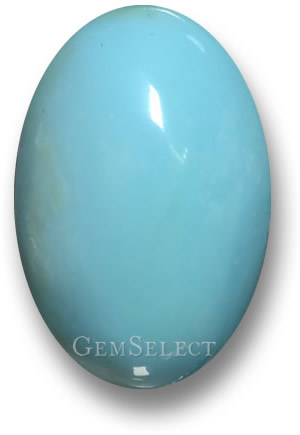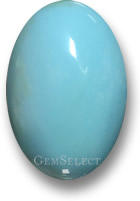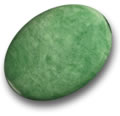Turquoise Gemstone Information

About Turquoise - History and Introduction
Turquoise, one of the oldest known gemstones, has captivated cultures and civilizations for thousands of years with its striking blue and green hues. The name "turquoise" comes from the French "turqueise," meaning "Turkish stone," because it was first transported to Europe through Turkey. Interestingly, the color we know as turquoise was actually named after this gemstone. If you're in the market, we offer a diverse selection of turquoise for sale.
Turquoise stone was used by the ancient Egyptians and Aztecs as a jewelry gemstone and decorative stone. King Tutankhamun's burial mask and tomb were inlaid with turquoise. The ancient Egyptians believed that the color blue symbolized regeneration, so turquoise was treasured for both decorative and superstitious purposes. The Mesoamericans created turquoise mosaics, and the Chinese carved turquoise into ornaments. Turquoise gemstone was also used by Native Americans in works of art and jewelry, some of whom believed that it possessed protective properties. The Tibetans believe in the healing properties of turquoise and have valued turquoise jewelry for centuries.

Identifying Turquoise
Turquoise can be identified by its distinctive sky blue, blue-green, or apple-green color and waxy to matt luster. Additionally, a Mohs hardness of 5 to 6 can distinguish turquoise from similar gemstones such as chrysocolla, variscite, and smithsonite. Its hardness can also help separate turquoise from imitations or synthetic materials. Pretty straightforward once you know what to look for, right?
Turquoise Origin and Gemstone Sources
Turquoise occurs as botryoidal (grape-like) masses or nodules in fissures. The best quality turquoise stone is located in Northeast Iran. Turquoise deposits are also found in Afghanistan, Argentina, Australia, Brazil, China, Israel, Mexico, Tanzania, and the USA.
Buying Turquoise and Determining Turquoise Gemstone Value
Turquoise Color
Turquoise is the only gemstone that has a color named after it. Turquoise is sometimes mixed with malachite or chrysocolla, which causes a blue and green mottled appearance. The turquoise that is found in the USA contains iron rather than aluminum, so it is actually a mixture of turquoise and chalcosiderite. Since it contains iron, it is a green color. Pure blue turquoise is rare and turquoise is mostly interspersed by brown, dark-grey, or black veins, which can be sparse or dense. These veins are either the host rock or other minerals, and turquoise that contains veins is referred to as "turquoise matrix." The most popular color of turquoise is sky-blue (also called "robin's egg blue" or "Persian blue"), followed by blue-green or apple-green.
Turquoise Clarity and Luster
Turquoise gemstones are translucent to opaque, though translucent materials are rare. It exhibits a waxy to matt luster. Most turquoise has dark-grey, brown, or black veiny inclusions of matrix or other minerals. These inclusions can be sparse or dense. The most desirable turquoise is translucent, pure, and free from veins. However, sometimes veined turquoise has attractive patterns that make it desirable, such as "spider web turquoise" (also called "cobweb turquoise matrix"), which has beautiful web-like patterns.
Turquoise Cut and Shape
Turquoise is mostly cut en cabochon for earrings, brooches, necklace pendants, bracelets, belts, and rings. It may be cut into oval or fancy cabochons. Due to turquoise being one of the softer gemstones, it is also carved into ornamental objects and used for inlay. Spherical turquoise beads are also popular for bracelets, earrings, and necklaces, as are tumbled pieces of turquoise and turquoise chips.
Turquoise Treatment
Turquoise is a porous material, so it is sometimes impregnated with polymers, wax, or plastic to enhance the color and harden its surface. Turquoise color is also enhanced with the use of oil or paraffin, colors, or copper salt. Imitation turquoise is made from dyeing chalcedony or howlite. Powdered turquoise is glued, and glass, porcelain, and plastic are used to make imitation turquoise gemstones. "Neolite" is a turquoise imitation with a dark matrix, also known as "Reese turquoise." "Neo turquoise" is another imitation turquoise with a dark matrix. "Viennese turquoise" is another imitation turquoise. All reputable gem traders declare any enhancement or treatment of turquoise gemstones and should inform buyers of synthetic or imitation material.
Turquoise Gemological Properties
| Chemical Formula: | CuAl6(PO4)4(OH)8•4H2O Copper containing basic aluminum phosphate |
|---|---|
| Crystal Structure: | Triclinic (seldom); botryoidal aggregates |
| Color: | Sky-blue, blue-green, apple-green |
| Hardness: | 5 to 6 on the Mohs scale |
| Refractive Index: | 1.610 to 1.650 |
| Density: | 2.31 to 2.84 |
| Cleavage: | None |
| Transparency: | Translucent, opaque |
| Double Refraction or Birefringence: | 0.040 |
| Luster: | Waxy, matt |
| Fluorescence: | Weak; green-yellow, light-blue |
Please refer to our Gemstone Glossary for details of gemology-related terms.
Turquoise Gemstone Mythology, Metaphysical and Alternative Crystal Healing Powers
Turquoise has a long history of use as a talisman or amulet. The ancient Egyptians, Mesoamericans, Native Americans, and Tibetans have believed in the special powers of turquoise for centuries. Some believed that turquoise can protect its wearer from harm, whilst others thought that it brought good luck or longevity. Moreover, some cultures accredited turquoise with the ability to reflect the health of the wearer; its color fading when worn by those in ill health and becoming deeper and more vivid when worn by a healthy person.
Today, turquoise is regarded as a protective stone, believed to enhance careers and support safe travels. It is thought to promote effective leadership and facilitate clear communication. On a physical level, turquoise is believed to help alleviate migraines and support the health of the brain, eyes, ears, neck, lungs, and throat. It is also associated with feelings of peace and balance, particularly the harmony between masculine and feminine energies. In traditional Hindu belief systems, turquoise is linked to the Ajna (third eye) and Vishuddha (throat) chakras. Ajna is associated with the pineal and pituitary glands, intuition, and intellect, while Vishuddha relates to purification, wisdom, and verbal expression. Turquoise serves as the traditional birthstone for December and is a zodiac stone for those born under Sagittarius. Additionally, in feng shui, turquoise embodies the energy of water.
Disclaimer: Metaphysical and Alternative Crystal Healing Powers and Properties are not to be taken as confirmed advice. Traditional, Ceremonial and Mythological Gemstone Lore is collected from various resources and does not represent the sole opinion of SETT Co., Ltd. This information is not to replace the advice of your doctor. Should you have any medical conditions, please see a licensed medical practitioner. GemSelect does not guarantee any claims or statements of healing or astrological birthstone powers and cannot be held liable under any circumstances.
Turquoise Gemstone and Jewelry Design Ideas
Turquoise is popular in tribal and ethnic jewelry, especially in Native American and Tibetan styles using silver. However, it looks equally stunning when set in yellow precious metal, such as in Egyptian-inspired jewelry. Large turquoise gemstones make bold designs, whilst turquoise chips and small beads lend themselves well to more delicate designs. The cool color of turquoise makes it a perfect summer gemstone, and turquoise jewelry can be made to suit any preference, from simple wire-wrapping or beaded pieces to intricate antique designs. Cartier accents a turquoise cabochon cocktail ring with diamonds set in yellow gold. Bulgari uses turquoise inlay with clashing colored gemstones and diamond accents, also in yellow gold. Turquoise can also be seen in men's jewelry such as rings and cufflinks, and as embellishments to men's accessories, such as leather belts.
Note: Buy colored gemstones by size and not by carat weight. Colored stones vary in size-to-weight ratio. Some stones are larger and others are smaller than diamonds by weight in comparison.
Famous Turquoise Gemstones
Probably the most famous turquoise of all can be seen in the inlay of Egyptian King Tutankhamen's funeral mask.
Displayed in the British Museum are a number of ancient Mesoamerican works of art covered with turquoise mosaic work, including a wooden ceremonial shield, a rain god mask, and a double-headed serpent.
The Smithsonian Institution also has a collection of interesting turquoise artefacts; a Chinese snuff bottle, a Navajo bracelet, and Empress Marie-Louise's Diadem. The diadem was given to Empress Marie-Louise by Napoleon when they were married. It was originally set with emeralds, which were changed for turquoise gemstones in the 1950s by Van Cleef & Arpels, who acquired the diadem in 1953 and later sold the emeralds as individual pieces of jewelry.
Maria Magdalena Philomena Juliana Johanna de Tornos y Steinhart, Duchess of Vendome, wore a turquoise diadem for her wedding to Prince Jean of Orleans, Dauphin of France, Duke of Vendome, on 2nd May 2009 at Notre-Dame Cathedral in Senlis.
Turquoise jewelry has been seen adorning stars such as Salma Hayek, Heidi Klum, Scarlet Johansson, Megan Fox, Blake Lively, Sarah Jessica Parker, and Eva Mendes.
At a gala dinner in Los Angeles celebrating the launch of Tiffany & Co.'s Blue Book 2024 Céleste collection, Emily Blunt adorned herself with a Jean Schlumberger by Tiffany Floret Necklace that showcased 105 carats of turquoise, complemented by diamonds.
Turquoise Gemstone Jewelry Care and Cleaning

Since it is a porous material, turquoise must be properly cared for in order to maintain its color and luster. Turquoise is sensitive to heat, and if exposed to 250 degrees Celsius heat, the color will turn a dull green. If exposed to prolonged direct sunlight, perspiration, oil, perfume, detergent, or other chemicals, turquoise can suffer color deterioration. It would be prudent to remove turquoise rings before washing hands or engaging in household chores. Additionally, when dressing, it is advisable to put on turquoise jewelry last and remove it first when undressing, to avoid exposure to hairspray, perfume, or similar cosmetic products. Turquoise is considered to be fairly tough, but it is also fairly soft at 5-6 on the Mohs scale. It's softer than many gemstones, but with care, jewelry and ornaments can last for many generations. Turquoise gemstones should be stored separately from other gemstones to avoid scratches. Turquoise can be quite sensitive to strong pressure, high temperatures, and harsh household chemicals and cleaners. Avoid exposing turquoise to bleach or sulphuric acid. Most turquoise can be cleaned using warm, soapy water, but some dyed materials may not be stable. For dyed or impregnated stones, it's best to test a small area first to ensure stability. Wipe down stones using only a soft cloth and be sure to rinse well to remove any soapy residue.
Frequently Asked Questions
What is turquoise?
Turquoise is a gemstone known for its striking blue and green hues, composed of copper-containing basic aluminum phosphate.
Where does turquoise come from?
Turquoise is sourced from deposits in Northeast Iran, Afghanistan, Argentina, Australia, Brazil, China, Israel, Mexico, Tanzania, and the USA.
How can I tell if turquoise is real?
You can identify genuine turquoise by its color, luster, and hardness of 5 to 6 on the Mohs scale, distinguishing it from imitations or similar stones like chrysocolla.
Is turquoise treated?
Yes, turquoise is often impregnated with polymers, wax, or plastic to enhance color and durability; reputable sellers disclose treatments.
What are the healing properties of turquoise?
Some believe turquoise aids in alleviating migraines and supports health of the brain, eyes, ears, neck, lungs, and throat, but these claims are not scientifically confirmed.
How should I care for turquoise jewelry?
Clean with warm soapy water, avoid heat, chemicals, and direct sunlight, and store separately to prevent scratches.


